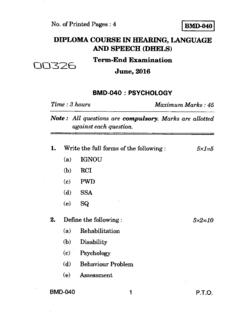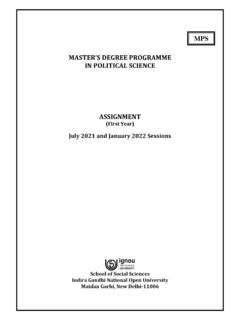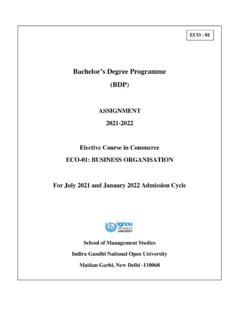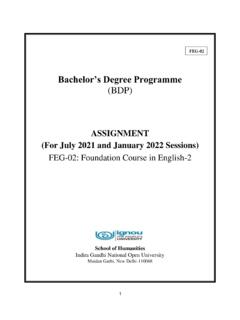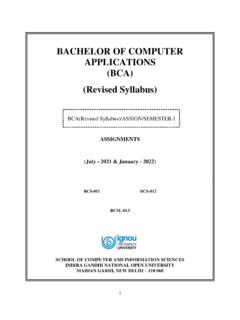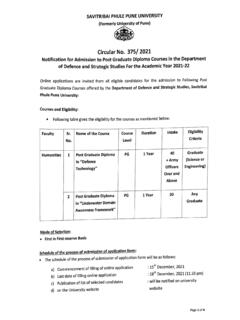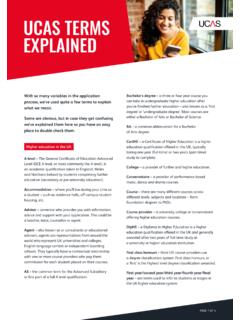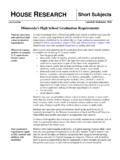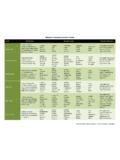Transcription of POST GRADUATE DIPLOMA IN COMPUTER APPLICATIONS …
1 post GRADUATE DIPLOMA IN. COMPUTER APPLICATIONS . PGDCA-(NEW). PGDCA-NEW/ASSIGN/SEMESTER-I. ASSIGNMENTS. (January 2021 & July 2021). MCS-201, MCS-202, MCS-203, MCSL-204, MCSL-205. SCHOOL OF COMPUTER AND INFORMATION SCIENCES. INDIRA GANDHI NATIONAL OPEN UNIVERSITY. MAIDAN GARHI, NEW DELHI 110 068. 1. CONTENTS. Course Assignment No. Submission-Schedule Pag Code e No. For January- For July- June Session December Session MCS-201 PGDCA(1)/201/Assignment/21 31stMay, 2021 31st October, 2021 3. MCS-202 PGDCA(1)/202/Assignment/21 31stMay, 2021 31st October, 2021 5. MCS-203 PGDCA(1)/203/Assignment/21 31stMay, 2021 31st October, 2021 7. MCSL-204 PGDCA(1)/L-204/Assignment/21 31stMay, 2021 31st October, 2021 9. MCSL-205 PGDCA(1)/L-205/Assignment/21 31stMay, 2021 31st October, 2021 10. Important Notes 1. Submit your assignments to the Coordinator of your Study Centre on or before the due date. 2. Assignment submission before due dates is compulsory to become eligible for appearing in corresponding Term End Examinations.
2 For further details, please refer to PGDCA Programme Guide. 3. To become eligible for appearing the Term End Practical Examination for the lab courses, it is essential to fulfill the minimum attendance requirements as well as submission of assignments (on or before the due date). For further details, please refer to the PGDCA Programme Guide. 4. The viva voce is compulsory for the assignments. For any course, if a student submitted the assignment and not attended the viva-voce, then the assignment is treated as not successfully completed and would be marked as ZERO. 2. Course Code : MCS-201. Course Title : Programming in C and PYTHON. Assignment Number : PGDCA(I)/201/Assignment/2021. Maximum Marks : 100. Weightage : 30%. Last Date of Submission : 31stMay, 2021 (for January session). 31stOctober, 2021(for July session). There are ten questions in this assignment which carries 80 marks. Each question carries 8 marks. Rest 20 marks are for viva-voce.
3 Answer all the questions from both the sections Section A and Section B. You may use illustrations and diagrams to enhance the explanations. Include the screen layouts also along with your assignment responses. Please go through the guidelines regarding assignments given in the Programme Guide for the format of presentation. SECTION-A (C-Programming). Question1: Write an algorithm, draw a flow chart and write its corresponding C program to convert a decimal number to its equivalent Binary number. (8 Marks). Question2: Write an algorithm and its corresponding C program to generate students' Progress-Report for VIII standard (section of 20 students) of a CBSE school for all its 4 terms. Use Structures concept. Assumptions can be made wherever necessary. (8 Marks). Question 3: Write a C program to generate the following pattern: (8 Marks). 1. 12. 123. 1234. 12345. Question 4: Write a C program to perform the following operation on matrices D = A + (B * C), where A, B and C are matrices of (3 X 3) size and D is the resultant matrix.
4 (8 Marks). Question 5: Write a C program to take a list of N numbers, separate even and odd numbers and put them in two appropriate files (evenfile and oddfile). Use File Handling concept. (8 Marks). SECTION-B (PYTHON-Programming). Question 6: Write a program in Python to check if a given year (entered by user) is a leap year or not, support your programme with suitable comments to improve readability (8 Marks). Question 7: Write a program to prompt for a score between and If the score is out of range, print an error. If the score is between and , print a grade using the following table (8 Marks). 3. Score Grade >= A. >= B. >= C. >= D. < F. Question 8: Write a programme in Python to create a package named Area and create 3 module in it named square, circle and rectangle each having a function to calculate area of square, circle and rectangle respectively. Import the module in separate location and use the functions. (8 Marks).
5 Question 9: Write a program in Python to perform following: (8 Marks). To find cube of numbers in a list using lambda function. To display frequency of each word in a file. To display first n lines from a file, where n is given by user. To display size of a file in bytes Question 10: What are Co-routines? How Co-routines support cooperative multi-tasking in python? How Co-routines differ from threads? Compare Subroutines and Co-routines. (8 Marks). 4. Course Code : MCS-202. Course Title : COMPUTER Organisation Assignment Number : PGDCA(1)/202/ Assignment /2021. Maximum Marks : 100. Weightage : 30%. Last Dates for Submission : 31stMay, 2021 (for January session). 31stOctober, 2021(for July session). There are four questions in this assignment, which carries 80 marks. Rest 20 marks are for viva voce. You may use illustrations and diagrams to enhance the explanations. Please go through the guidelines regarding assignments given in the Programme Guide for the format of presentation.
6 Answer to each part of the question should be confined to about 300 words. Make suitable assumption, if any. Question 1: (2 marks each 10 parts =20 Marks). (a) Explain the features of von Neumann architecture with the help of a diagram. (b) Differentiate between von Neumann architecture and Harvard architecture. (c) Perform the following conversion of numbers: (i) Decimal (384748940)10 to binary and hexadecimal. (ii) Hexadecimal (FAB3 CDE)h to Octal. (iii) String The escape sequence \t represents tab to UTF 8. (iv) Octal (7651234)O to Decimal (d) Simplify the following function using K-map: F(A, B, C, D) = (2, 3, 4, 5, 9, 14, 15). Draw the circuit for the function using NAND gates. (e) Consider the Adder-Subtractor circuit given in Unit 3 of Block 1. Explain how this circuit will perform subtraction (A-B), if the value of A is 1010 and B is 0101. You must list all the bit values including Cin and Cout and overflow condition.
7 (f) Explain the functioning of a 3 8 Decoder. You should draw its truth table and explain its logic diagram with the help of an example input. (g) Assume that a source data value 1111 was received at a destination as 0111. Show how Hamming's Error-Correcting code will be appended to source data, so this error of one bit is identified and corrected at the destination. You may assume that error while transmission occurs only in the source data and not in the code. (h) Explain functioning of SR flip flop with the help of a logic diagram and characteristic table. Also explain the excitation table of this flip-flop. (i) Explain the functioning of master-slave flip flop and a two bit Synchronous counter with the help of a diagram of each. (j) Represent ( )10 and ( )10 in IEEE 754 single precision format. 5. Question 2: (4 marks each 5 parts =20 Marks). (a) What is the purpose of creating memory hierarchy? Explain the concept of DRAM.
8 Also explain how access time of Hard disk drive is computed? Differentiate between the hard disk and optical disk characteristics. (b) Explain the following cache to main memory mapping scheme with the help of an example and suitable diagram. (i) Direct cache mapping (ii) Two way set associative cache mapping (c) What is DMA? Explain its importance with the help of a diagram. How DMA is different than I/O. processor? (d) Explain the use of Interrupt in Input/output with the help of an example. How multiple interrupts, that occur simultaneously, are handled? (e) Explain the technology of any two Input/output devices in details. Question 3: (4 marks each 5 parts =20 Marks). (a) What are various components of an instruction of a COMPUTER ? Explain with the help of a diagram and example. (b) Explain any four addressing modes with the help of an example, showing instruction and operands. (c) What is a micro-operation? Explain different types of micro-operations with the help of one example each.
9 (d) Explain the working of micro-programmed control unit with the help of a diagram and example. (e) What are the characteristics of RISC? Explain the use of large register file of RISC with the help of an example/diagram Question 4: (5 marks each 4 parts =20 Marks). (a) Explain the different components of 8086 micro-processor. Explain any four addressing modes supported by this micro-processor, with the help of an example each. (b) What is the use of Interrupt 21h? Explain with the help of an example. Also, differentiate between the .com and .exe programs. (c) Write a program in 8086 assembly language, which converts a two digit ASCII number to its equivalent binary value. Explain each step of the program. Assume that the ASCII digits are in two different byte locations of the memory. (d) Explain any two architectures in brief: (i) Instruction Pipeline (ii) Multiprocessors 6. Course Code : MCS-203. Course Title : Operating Systems Assignment Number : PGDCA(1)/203/Assignment /21.
10 Maximum Marks : 100. Weightage : 30%. Last Date of Submission : 31stMay, 2021 (for January session). 31stOctober, 2021(for July session). This assignment has five questions. Answer all questions. Rest 20 marks are for viva voce. You may use illustrations and diagrams to enhance the explanations. Please go through the guidelines regarding assignments given in the Programme Guide. Question 1: (15 Marks). Consider the following jobs: Job # Arrival time Run time A 0 3. B 2 4. C 3 3. D 5 7. a) Using the SJF method, compute the completion times of the above jobs, average turn around time and average waiting time. b) Using the SRTF (Shortest Remaining Time first) method, compute the completion times of the above jobs, the average turn around time and the average waiting time. Note that SRTF is SJF. with preemption. (Hint: Completion time - arrival time = turnaround time). c) Using the Round Robin method (with Quantum = 2), compute the completion times of the above jobs and the average waiting time.

